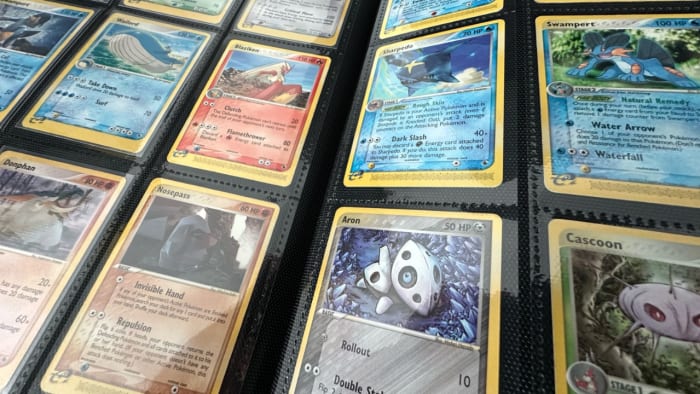If you were a child at some point since 1990, then chances are likely that you or your friends collected Pokémon cards.
Being the most valuable media franchise in the world, it’s no surprise there have been plenty of young fans who collected entire binders’ worth of these collectible cards.
Years later, and many of these cards are worth hundreds — if not thousands — of dollars thanks to nostalgia-driven fans who are trying to complete their childhood collections or collect vintage memorabilia.
Below are six tips to figure out whether your collection is worth a fortune or just a few pennies.
1. LOOK FOR SHINY CARDS
It’s no surprise that shiny sparkles tend to indicate rarer cards. If your card has some holographic foil on it, chances are it’s going to be worth a lot more than something that doesn’t.
Alternatively, different types of card games have different levels of rarity. Usually, cards go by one of a few select levels:
-
Common
-
Uncommon
-
Rare
-
Super Rare
The “Super Rare” category typically has the shiny foil you should be looking for, though you can take a look at the lower-righthand side of the card to make sure. There’s typically a symbol that indicates the card’s rarity.
There are also “Promo” cards that were typically given away via special events or by purchasing specific goods. These can vary in value, as some were printed super selectively, and others were distributed out the wazoo.
However, this is just a general guideline. The types of rarities are going to differ based on what sets you’re looking at and when they were released. And that brings us to the next tip.
2. FIGURE OUT HOW OLD IT IS
Even if your card is nice and sparkly, it doesn’t really mean much if it was printed recently. A lot of the more valuable cards are those that were released a while ago.
When a lot of trading card games were first being released, there were limited prints because companies weren’t yet sure whether they’d sell well.
However, as these games caught on, companies have printed more and more each year, meaning that recent cards don’t tend to be worth as much unless they’re exceedingly rare.
How do you figure out when your card came out? The dates are typically printed at the bottom of the card, so it should be easy to spot.
3. WHAT “SET” IS IT FROM?
If you ever tried to collect cards, you probably did so by ripping open a plastic “booster pack.”
These packages were printed with interesting designs to stand out and attract players. They also contained around 8-10 cards (give or take) that came from a predetermined group of possible cards players could pull.
This group of possible cards is called a “set,” and some are worth way more than others.
But how can you tell what set a card is from?
Before 2002, cards had a logo on the center-right of the card just below the artwork to indicate which set it was from. This eventually transitioned to the bottom right, though the most recent sets have them in the bottom left.
For a full list of sets, you can visit the company’s website here. Just scroll back to when the card came out and find the set with the same symbol.
4. WHAT IS THE CONDITION?
The reason that many older cards are more valuable is not only because of the fact they’re not in circulation. It’s also because children aren’t generally good at taking care of their belongings.
Older Pokémon cards were frequently played with or damaged by children, so there aren’t many that are in perfect condition.
If you have something that seems valuable, make sure to check it for any nicks, creases, tears or fading. A little wear and tear won’t bring down the value too much, but enough imperfections will cause the value to plummet.
Card conditions are generally as follows, with better conditions being worth more money:
-
DAMAGED: Severe border wear, corner wear, scratching, scuffing, folds, creases, tears or other severe damage
-
HEAVILY PLAYED: Major amount of wear, including creasing, whitening and bends
-
MODERATELY PLAYED: Little border wear, corner wear, scratching, scuffing, creases or whitening
-
LIGHTLY PLAYED: Minor border wear, corner wear, scuffs or scratches. No major defects like grime, bends or issues with structural integrity
-
NEAR MINT: Minimal wear with a nearly unmarked surface
In addition, if there is any kind of substance like food or fluid caked on the card, it’s considered unsellable on several online marketplaces.
For a more in-depth demonstration, click here.
5. IS IT A FAN-FAVORITE?
You have to be somewhat knowledgeable about the franchise for this one. Certain “fan-favorite” mascots and cards tend to have a higher value than others.
For example, “Charizard” cards tend to be more expensive than many other cards simply because fans love the creature.
Other fan-favorite characters to look out for include “Pikachu,” “Eevee,” and “Mewtwo.”
6. REFERENCE THIRD-PARTY SELLERS
Once you’ve identified what your card is, take a look on third-party selling sites like eBay, Facebook Marketplace and Mercari.
You can use these platforms to figure out what your card is selling for and how many people are interested in buying it.
One of the best reference sites you can use is TCGPlayer, which provides up-to-date data on market prices and conditions of certain cards.
Once you have a good idea of what your card is worth, then you can make an account on any of these websites and try selling for yourself.
Good luck!
Get today’s headlines in minutes with Your Florida Daily:
Copyright 2023 by WKMG ClickOrlando – All rights reserved.





